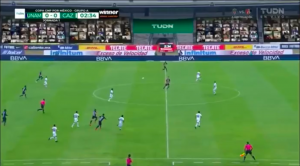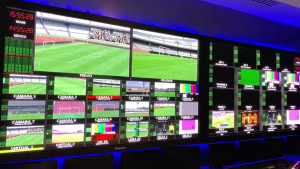Univision’s TUDN Virtualizes At-Home Fútbol Fans for Inaugural Copa por México
The technology will be used for the upcoming 2020 Liga MX schedule
Story Highlights
In Mexico, fútbol is the lifeblood of the sports culture. With venues closing their doors in response to COVID-19, the first-ever Copa por México was played without fans in the stands. Instead, Univision’s TUDN deployed augmented reality and video conferencing to transport spectators from their living rooms to front-row seats along the pitch.

As fans watched each Copa por México match from home, TUDN gave a select few the chance to be virtually shown in the stands.
“After evaluating multiple solutions with virtual fans, we took a different and innovative approach where we decided to take you into the stadium,” says Alexis Salinas, senior director, technical creative services, TUDN. “It was a combination of video conferencing with hundreds of fans watching the game on their computer or phone and proprietary, image-based camera tracking.”
Packing an Empty Stadium: Three Iso Cameras, Unlimited Video Space for Virtual Crowd
In the U.S., franchises have resorted to implementing cardboard cutouts of fans inside their venues, but, for TUDN, the network was itching to flex its technological and creative muscles for this tournament. As momentum for virtual fans grew in Europe for leagues like Spain’s LaLiga and Italy’s Serie A and Coppa Italia, TUDN wanted to take it up a notch for this new eight-team tournament. To capture the vast digital landscape of tiny squares, the production team dedicated three cameras with the help of its camera-tracking partner in Mexico.
“All of this was done in real time, which makes it different from the other implementations that we have seen in La Liga and Serie A,” says Salinas. “We feel that it was less intrusive and better integrated with the stadium. All of these fans were not really virtual, but they were virtually located inside the stadium. They were mapped into the bleachers with the same perspective [as the in-venue fans], so it provided a more fun experience for the at-home audience.”
As three cameras provided feeds to the production team, the graphics team developed a transmission path and graphics layout for an incalculable amount of video real estate. “There was essentially no limit on the number of fans since they could have multiple accounts,” Salinas explains. “If someone wanted one [box] for each team, they could have a virtual background with a logo of the team.”
As with Major League Soccer‘s return to play in Orlando, the interactivity and intimacy that this platform presents is an impressive touch, but, for those working behind the scenes, the real-time element can present a challenge in terms of security. For this aspect of the operation, the network screened each call before allowing the caller into the pool of fans.
“It was important for us to make sure that we didn’t have any situation that is inappropriate on the air,” says Miguel Angel Garcia, SVP, live events, TUDN. “We worked with the clubs and their fan base to create a controlled atmosphere they were committed to, and [they were] well behaved.”
Production in this ongoing pandemic is stressful enough. With virtual fans into the mix, these broadcasts became an ambitious yet daunting endeavor.
“In our world,” says Garcia, “there were elements like sponsorship, commentary, a sideline reporter, and social media integrated into the games. “Now there was another component, which takes a lot of your attention because our production team had to monitor every single window at the same time before sending them on-air.”
Along with this added responsibility, the idea was solely dependent on fan buy-in. In an age when screen-time consumption is extremely high, less than full participation from selected fans would make this initiative a harder task to execute.
“We needed to have a lot more people than what was expected,” adds Salinas, “because engagement for a complete game is a little challenging.”
Although a bulk of the production was facilitated in TUDN’s office in Mexico, the network’s satellite location in Miami also played a vital role. For Copa por México, the stateside facility was the primary conduit for all on-screen graphics, including the virtual fans and sponsorship messaging that coordinated with each given match.
“Since we have two facilities and a game that has different sponsorship in the U.S. and Mexico, we do what we call a dual production, where we insert all of our graphics and everything out of Miami,” says Garcia. “As far as implementation of sponsorship, graphics, and commentary, it all depends on which game is going to be on the air.”
Planning Ahead: Production Hubs for Liga MX Fixtures
After being postponed a few months, the Torneo Guardianes — the temporary name for the Apertura section of the season to honor medical personnel fighting the pandemic — will finally be played at the end of this month. With resources from Miami, TUDN will be conducting a milestone achievement for these upcoming fixtures.
“We’re going to be remotely producing from two stadiums at the same time, Estadio Olímpico Universitario and Azteca Stadium [in Mexico City], which will be the first time in Mexico,” says Garcia. “We already did it last season in Estadio Universitario [in San Nicolás de los Garza] and possibly a fourth one, so that allows for less people at the stadium. We will have an average of 20-25 people that will be at each stadium and follow the new workflow.”
For these productions, the crew will be thinking of intriguing ways to showcase the action with limited access to the field of play. Without any spectators, the network has extra room to work with.
“We’ll be modifying and changing some of our camera angles to capture coaches and players,” he explains. “Some of the low–end-zone cameras are going to expand, and we’re bringing some additional infrastructure, but we’re adding value by showing more of the players’ faces and the intimacy of the game itself. Overall, it’s going to be a more enhanced experience for the fans.”
When those fans tune into Atletico San Luis vs. FC Juarez on Thursday, July 23 at 10 p.m. ET, they will illuminate the space where empty stands would be. It’s a sign of the unprecedented era that Liga MX will play in.
“Our aim is to look at different options and experience the game as close to what they were experiencing before [the pandemic] as possible,” says Garcia. “Not only are we bringing them to the stadium, but we’re also adding a whole library of [edited] match sounds of each of the home clubs. We want to make it as real as possible.”
After a four-month schedule, Liga MX’s Torneo Guardianes will conclude on Saturday, Dec. 12.

